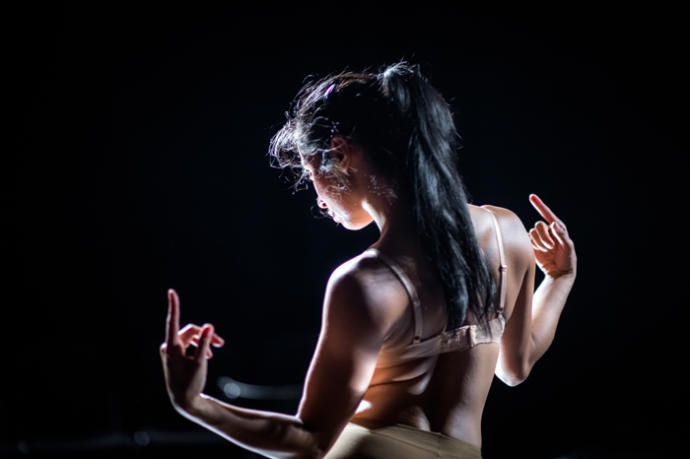So I'd like to share something with you. (I like dance. That's the main reason.)
Now at first glance this may look, on the surface, like a sort of gender-bending statement about androgyny. It's not.
And maybe, like me, you were instantly both interested, and slightly confused. (And why is she chewing gum?? Ooh, it's part of the 'macho-ness.' I see.)
Maybe you, like me, thought briefly that this was a Thai 'ladyboy.'
Then you decided, "Nah, it's a girl!' And depending on your sex, gender, sexual inclinations, etc. maybe you were either attracted or repelled.
Anyway, I really don't care what your sexual orientation is. Or what your feelings on LGBTQ are (I'm not getting into that. But my belief is 'live and let live.' I don't tell anyone who they should spend their time with.)
But what I wanted to share is how aesthetically... [pleasing? beautiful? sexy? hot?] this is. I've been sort of transfixed with it ever since I came across it recently.
And the reason is not because it makes me question or change my sexuality (I'm straight, always have been), but I've figured out it's because of the artistry, the artist, and how consciously and deliberately she constructed, choreographed, this dance. She is genuinely very talented. I've seen male strippers perform (back in my early 20s) and I was never into it. And I do not find lesbian sexuality appealing (no, I never watch lesbian porn, I have no interest in it whatsoever), but this new, somewhat bizarre, combining of male striptease with the delicateness of a female's interpretation and movements, seems to have created a hybrid form that I do like. (While also not wanting anything sexually to do with her.) I just really appreciate the art.
Singer/Songwriter: Peaches, Song: 'How You Like My Cut'
Dancer/Choreographer: Eisa Jocson
Performance: 'Macho Dancer'
So what is it?
"From pole dancing to macho dancing, Eisa Jocson investigates the economic challenges of those working in the professional sex industry, service industry, and exposes gender formation, seduction politics, and Filipino social mobility. Her research on the practice of macho dancing, or dancing by male performers in gay bars in the Philippines, has culminated in a performance piece titled “Macho Dancer.”
"Macho dancing is performed by young men for both male and female clients, and is a unique phenomenon in the Philippines. It is an economically-motivated language of seduction that employs masculinity as body capital. The language is a display of the glorified and objectified male body as well as a performance of vulnerability and sensitivity. By framing a woman’s (not man's) body in the act, Jocson challenges our perception of sexuality and questions gender as a tool for social mobility."



"'Death of the Pole Dancer' interrogates the way we look at what we think we look at. The audience is brought to reflect on what they witness: a woman during the act of pole dancing. The performance renegotiates notions such as voyeurism and restrain, vulnerability and violence, sexuality and power."

https://eisajocson.wordpress.com/
Biography:
"I received training at the Philippine High School for the Arts and the College of Fine Arts at the University of the Philippines. I had classical ballet training from 7 till 12 years old. I decided to enter PHSA with a focus on visual arts and took ballet as an elective. I then continued my education in visual arts at the University of the Philippines, College of Fine Arts majoring in Sculpture. On my 3rd year of university, I had to choose between taking up nursing or visual communications. I chose the latter.
Ballet was formative in my physical and movement orientation. My visual arts education and practice gave me access to theoretical discourse. Pole dancing enabled me to investigate movement in relation to its social context.
In 2012, I moved away from pole dance as a tool in my artistic practice. I decided to learn the opposite gendered language in the realm of night work – macho dancing. Visiting several macho clubs on a regular basis, I invited good macho dancers to teach me. It took me a year to become aware of existing movement habits and to transform the movement practice of my body. A change of lifestyle was necessary; going to the gym became part of the research. I was stepping outside my given body politics as a woman as well as expanding spatial sphere into the urban nightclubs of Manila.
The work Macho Dancer was made between Manila and Brussels. It premiered in Brussels in 2013 and toured different cities in Europe, America and Asia. I work between Manila and where there is support for what I do; Belgium, Germany, Switzerland, Japan, Hong Kong etc.
I approached Patrick Flores of Vargas Museum to make an exhibition about the process behind Macho Dancer which resulted in a solo exhibition in March 2014 titled: PMA; Philippine Macho Academy. The exhibition refers to a fictional institution of masculinity. It was then invited to the Wifi contemporary dance festival 2014 in Cultural Center of the Philippines.
The idea for the next work came in 2011 when I first visited Japan. Curious about the existing relations of Philippines and Japan I became fascinated with how Filipino/a entertainers negotiated their identity to fit into the demands of their Japanese clients."

Hugo Boss Greater China awarded Eisa Jocson the Hugo Boss Asia Art Award for Emerging Asian Artist of 2019.
 Sexual Relationships
Sexual Relationships  Sexual Health
Sexual Health 













Most Helpful Guys